Layers of slow-cooked pork and soft white beans, spiked with greasy duck meat, a faint tang of tomato, and an oh-so porky stock percolating up and down below a toasted crust of breadcrumbs – there are many French farmhouse dishes that lean nonchalantly on their pitchfork of simplicity, but hide a complexity born out of understanding how to get the best out of the ingredients to hand. Cassoulet is one such dish.
Originating from the Languedoc region of France, with Toulouse as its capital, the cassoulet marries cheap cuts of pork with confit of duck and the heavy, meaty Toulouse sausages that are every bit the cylindrical equal of the Airbus A380 jet that is built at the city’s expansive airport – they are big, they are round, and they weigh more than a fully laden 18-wheel Renault truck.

Airbus A380 – slightly larger than a Toulouse sausage
As you can imagine, with a dish that uses off-cut pig skin, crap pork, beans and “meat in tube form” as Anthony Bourdain is wont to say, this dish was born out poverty, lack of resources, and a need to fill the bellies of people living out in the open with basic shelter and alarming skin diseases. With its origins lying many hundreds of years ago, it is not surprising that pinning down its genesis is trying to nail an angry cobra to chopstick.
The most historically romantic story of the cassoulet comes from the 1355 Siege of Castelnaudary by the army of the Black Prince – the then Edward Prince of Wales (who managed to die before he could access to the throne). This siege was part of the fabulously complex Hundred Years War in which the English ruling House of Plantagenet was locked in an seemingly endless scrap with French House of Valois. The poor people of Castelnaudary, caught in the crossfire and faced with being starved into surrender by the English, pooled their remaining caches of food, put it all in a huge cauldron, and cooked up the first cassoulet. Whether they liked it or not is not recorded.

Edward, Prince of Wales (1330–1376) – The Black Prince. Painting by Benjamin Burnell.
Other, less hot-headed historians point to the Arabs and Moors moving in and out of Europe as the source of bean stew, which seeded itself not only in France, but also in the Moorish incursions of Spain where bean stews made with offcuts of animals are also commonplace. I have a problem with handing this to the Arabs. They have produced so much more interesting stuff than the cassoulet, and there are no eastern spice influences in the classic cassoulet recipes. I still like to think that the women of Fourteenth Century Castelnaudary emptied their larders into a giant pot in the middle of the castle keep, while children in rags, smelling of cow shit, wailed from the corners of the mud-floored room.
Whatever the origin, the cassoulet of today has three essential etymologies: Castelnaudary, Carcassonne and Toulouse. In Carcassonne, cooks add partridges and lamb to their cassoulet. In Toulouse they use confit of goose, pork skin, and Toulouse sausages. The Castelnaudary version calls for the earthenware ‘cassolle,’ in which the cassoulet is cooked, to be fired by burning gorse wood. However, whatever anyone believes to be the definition of the classic cassoulet, you can be sure that the best cassoulet in the world is not going to be found in a restaurant. It will be found slowly bubbling over the hearth of a farmhouse kitchen, tucked away near a duck pond in Languedoc, with a stock of pigs nearby, and fresh hams drying on hooks, way up in the ceiling.
When we made our cassoulet we used a combination of resources. We followed Anthony Bourdain for the basic method, Lesley Styles’ Scrumpdillyicious for some furiously researched authenticity, and Larousse Gastronomique as a sense check. This enabled us to produce our own version of a cassoulet, with plenty of flavour, and some of the slightly inexplicable cooking times cut by good chunk.
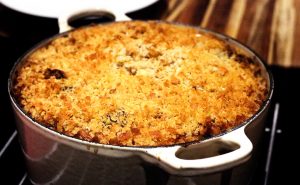
The cassoulet as it came out of the oven
We obtained Toulouse sausages from FrenchClick. We made our own confit of duck according to our own recipe, but you can also buy this.
To obtain the required pork skin, buy a piece of belly, skin it, and use the meat to make bacon according to our simple method. Reserve the skin for the cassoulet. If you are adding pork shoulder, then take the skin off this too, and add it to your skin hoard. If you are short on skin, then use what you have for the lining of the casserole (this is essential), and use a split or boned pig’s trotter in the bean stock – those are so cheap, some butchers will give then to you for nothing. The butcher will split them for you, but he sure as heck won’t bone them.
Cassoulet
Ingredients
- 2 confit duck legs, shredded off the bone (see recipe and shopping links above – this takes 1–2 days to make, but with no real effort or input time)
- 500g dry cannellini beans
- 1 onion quartered
- 1 carrot, chunked
- 1 stick of celery, chunked
- 1 bouquet garni (tie parsley stalks, bay and thyme together with string)
- 2–3 whole pieces of rind cut from pork belly (read the recipe through – rind is needed at two different stages in the process and for different purposes; for the first stage, you could use 2 front pig trotters, whole)
- 1 tbsp goose or duck fat
- 1 onion sliced
- 2 cloves of garlic, minced
- 4 Toulouse sausages
- 500g pork shoulder, cut into chunks
- 200g bacon lardons, ideally the same size as the pork dice (ask a butcher for unsliced streaky bacon, or make your own bacon if you can't get this, then just pick up some pre-diced lardons)
- 3 tbsp tomato purée
- 2 large handfuls of breadcrumbs
Instructions
On Day 1, prepare your confit of duck if you are making it yourself. You don't necessarily need to cure overnight – a good few hours will do the job, leaving 2h for the cooking in fat. Also on Day 1, soak the beans in cold water, leaving a good 3 inches of water above the level of the beans. Cover overnight.
On Day 2, start by making cooking the beans and making a stock all in one go. Cook the beans in simmering water with a piece of the pork rind (or trotters), the celery, carrot, quartered onion and bouquet garni. Simmer for 1 hour until the beans are just soft.
Meanwhile, heat the goose or duck fat in a large sauté pan and brown the pork, sausages, bacon. Remove to a plate. Sauté the onions in the same pan for 10 mins until soft. Add the garlic and cook for a further minute. Add the pork, sausages and bacon back to the pan, and add the tomato purée and a ladle of stock from the simmering beans. Cover (ideally with a glass lid so you can see what's going on) and cook on low for an hour, taking care not to dry the pan out. Add a touch more stock if needed.
While the meat is cooking, drain the beans, and reserve the stock. Discard the vegetables, rind and bouquet garni. Season the stock to taste. This is the only opportunity to season the dish, so be critical and diligent in your efforts.
Pre-heat an oven to 180˚C.
Line the bottom of an oven-proof casserole with a sheet of rind, skin side down. Use any additional rind to line the sides of the casserole a little like a pie pastry.
Layer the dish up with a layer of beans, a layer of meats, a layer of beans, a layer of meats, and finally a layer of beans. Pour in the stock so it just comes up to the level of the last bean layer. Cover over with the breadcrumbs to form a crust. Place in the oven at 180˚C for 1 hour. After 1 hour, turn the oven down to 130˚C and cook for a further hour.
Once done, remove from the oven and serve.
Notes
Cassoulet does not warrant a side dish, so to create a balanced meal, consider a salad starter, and a zippy citrus dessert.

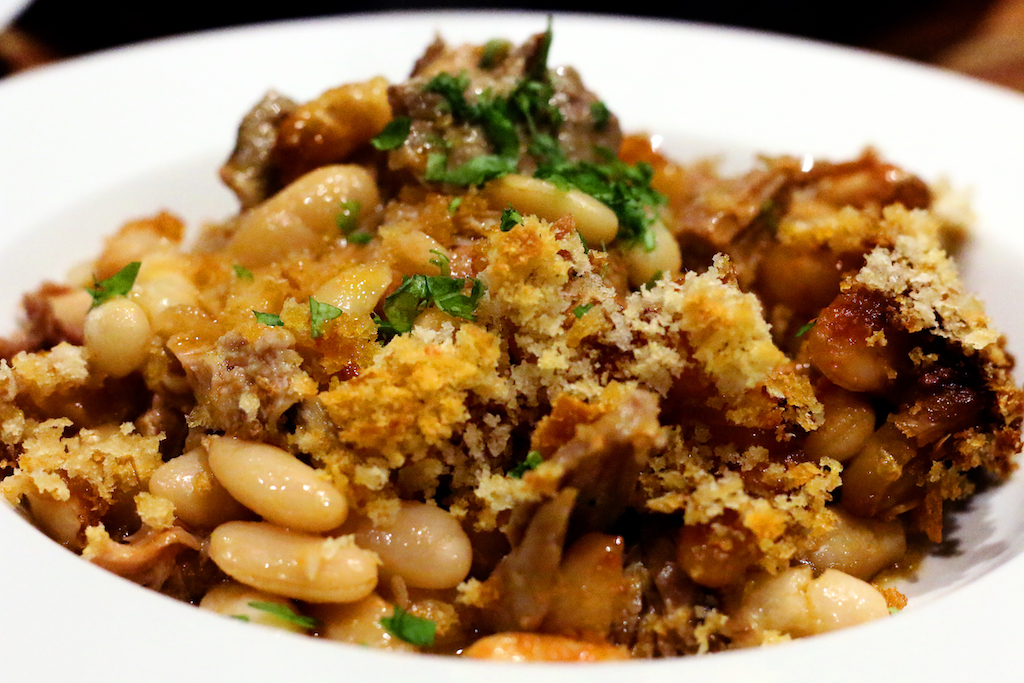

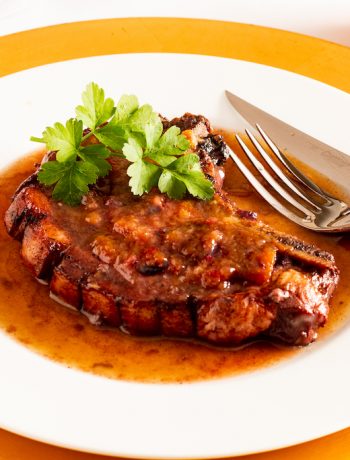
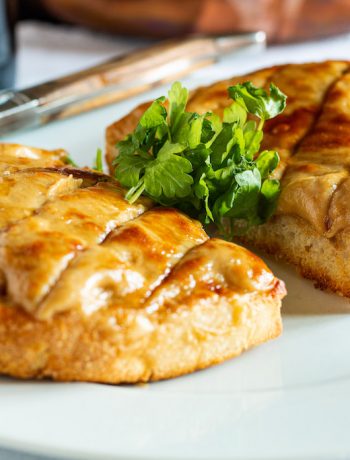
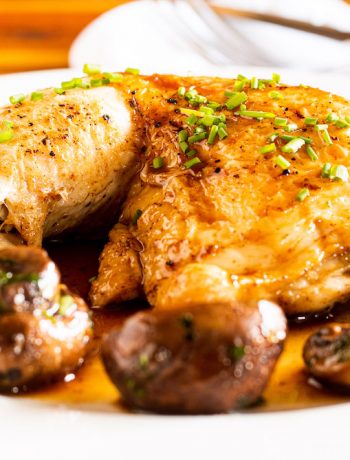
No Comments